Year 1 & 2 Literacy & Learning Resources
Start by using the filters on the left to help you find the resources and downloads that match your needs.
Hide Filters
No filters applied. Showing all results

Sort By
Year Group 
Program 
Type 
Comprehension Questions for 6 and 7 Year Olds
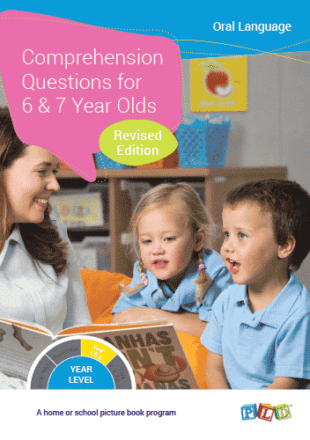
Picture Book Program for 6 & 7 Year Olds: Perfect for Home or School
Comprehension Questions for 6 and 7 Year Olds is a home or school resource designed to support oral language development in young children. From a young age, children should be verbal, actively engage in social interactions and understand simple, literal questions about their surroundings. By age 6 and 7, children begin answering more complex questions requiring prediction, interpretation and evaluation. This program, developed by speech pathologists, supports the development of these foundational comprehension skills using engaging picture books to ask age-appropriate questions and assess oral responses. Oral language skills are critical for social interaction and academic success. Program Includes: Picture Book Recommendations: List of developmentally appropriate Picture Book recommendations, such as 'Arthur', 'The Rainbow Fish' and 'Possum Magic'. 40 Question Cards for Repeated Reading Sessions: Develop blending skills through engaging visuals. Each card contains sample questions (over four days) and model answers based on each recommended picture book. Questions are focused on encouraging students to predict, to interpret and to evaluate, such as 'What would happen if…?', 'How can we tell…?' or 'Which part of the story…?' Instruction Booklet: Guidance for presenting in group, class or home settings. Strategies for Success: Techniques for responding to inadequate answers. Progress Check: Two assessments to monitor comprehension skill development. Other Programs within the Range: Comprehension Questions for 3 Year Old (Mc3) Parent Training Video: 3 Year Olds Comprehension Questions for 4 Year Old (Mc4) Parent Training Video: 4 Year Olds Comprehension Questions for 5 Year Old (Mc5) Parent Training Video: 5 Year Olds Comprehension Questions for 6 and 7 Year Old (Mc6) Parent Training Video: 6 and 7 Year Olds Comprehension Questions for 8 and 9 Year Old (Mc8) Parent Training Video: 8 and 9 Year Olds The full set of Comprehension Questions Range (Mc3/4/5/6/8) Links to the Teaching Sequence Manuals: This product can be used to support the implementation of the Year 1 and 2 Teaching Sequence Manual on Page 27
10 Minute Language Games – Set 2
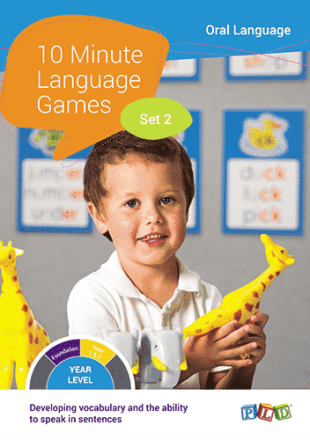
Developing vocabulary and the ability to speak in sentences.
Introduction to the Program This program is designed to provide quick, engaging activities that foster oral language development in young learners. Each game takes just 10 minutes, making it easy to incorporate into daily routines or classroom sessions. The Program Includes: 6 themes, each with 3 different language games Naming and speaking in single words Sorting and speaking in short sentences Describing and connecting several sentences together Vocabulary focused on real-life categories relevant to children Food Things you wear Farm animals Things that take you places Toys Around the home Activities tailored to 3-5 year old language development stages Other Programs within the Range: 10 Minute Language Games – Set 1 10 Minute Language Games – Set 2 Links to the Teaching Sequence Manuals This product is mentioned in the Early Years Teaching Sequence Manual
Semantic Scenes and Questioning – Set 2
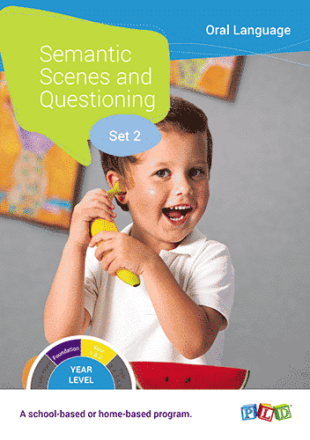
A school or home based program designed to equip teachers and parents of 5-6 year old children with activities that will develop semantic knowledge.
Semantic Scenes and Questioning – Set 2 is designed to equip teachers and parents of 5-6 year old children with activities that will develop semantic knowledge. A good grasp of semantics broadens a child’s understanding of the meaning of words, which then helps them to understand what they hear or read and also helps them to express exactly what they want to say. A child who is struggling with semantics will be the child who: Can’t stay on the topic of simple story or news telling, but goes off on unrelated tangents. Takes a long time to think of particular words they want to use in conversation. Uses non-specific vocabulary such as ‘that’ ‘there’ ‘this one’. Has difficulty sorting items into groups, describing them, and finding differences and similarities. Has difficulty understanding instructions that include time vocabulary such as ‘before’ ‘after’ ‘first’ etc. ‘Semantics’ refers to the meaning of sentences and words and how words relate to one another. That is, whether words belong in groups or categories together (e.g. Apples and oranges and pears are all fruit), whether they are similar to each other, or different and the features they have e.g. Size, shape and colour. Another way to think of semantics is like a network or web. Each word we speak or read has a place in this web. Each word has other words linked to it, some closely related and some distantly related. Each word belongs to several groups, some big and some small and each word has a definition that sets it apart from other words that are similar. Some words are related by the fact that they are actually opposites! All this information surrounding words is what we aim to teach young children about the vocabulary that is appropriate to their stage of development and life experience. Semantics is one facet of oral language. Given that oral language is not only a strong predictor of academic and social success but also a necessary requirement for good mental health, it is important that parents and teachers have the skills and resources needed to facilitate the development of oral language in young children. The aim of this program is to train parents and teachers to structure and facilitate developmentally appropriate semantic activities for 5 to 6 year old children. This program provides: Semantic activities and accompanying picture resources. Examples of appropriate and inadequate responses for 5-6 year old children. Techniques and strategies to implement when a child provides an inadequate answer. Features: Colour thematic picture scenes include the zoo, transport, at home, food, school, toys, Australian animals, clothes, under the sea and birthday party. Specific semantic questioning is outlined for each picture scene. Examples of appropriate and inadequate responses for 5-6 year old children. Techniques and strategies are outlined when a child provides an inadequate answer. This product is mentioned in the Foundation Teaching Sequence Manual on page 13 and the Year 1 & 2 Teaching Sequence Manual on page 20. The programs within the range include: Semantic Scenes and Questioning – Set 1 Semantic Scenes and Questioning – Set 2
Generating Narratives – Set 2
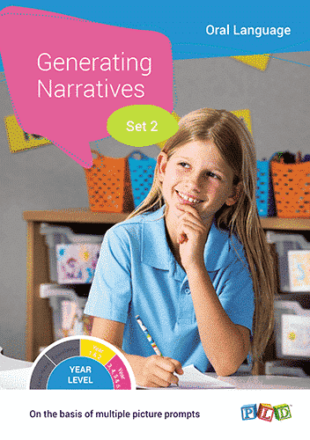
A resource for helping children to start expressing themselves verbally and in writing through the use of multiple picture prompts.
Generating Narratives: Set 2 supports Year 1 to 6 students develop verbal and written storytelling skills. Using picture prompts, this resource breaks narratives into three key components: An introduction to set the scene. A complication or problem. Characters' thoughts and feelings. This program is ideal for building students' confidence in both oral and written expression, whilst fostering creativity and a deeper understanding of story structure. Program Includes: A4 book: Spiral-bound, full colour and no preparation required. 10 Storylines & Picture Cards: each with three accompanying A4 Picture Cards illustrating narrative structure (30 cards in total). Included story themes: Escape from Prison Leaky Boat Storm Ruins Picnic The Fly Away Kite Soccer Grand Final Car Breakdown Hairdressing Disaster UFO House on Fire Shark Attack Narrative Structure Cards: includes 10 x A4 coloured narrative structure poster cards for display. Implementation: Picture cards guide students through introductions, complications and emotions, providing repeated practise in generating ideas and composing stories. Other Programs within the Range: Generating Narratives – Set 1 Links to the Teaching Sequence Manuals: This product can be used to support the implementation of the Year 1 and 2 Teaching Sequence Manual on Page 27 This product can be used to support the implementation of the Year 3, 4, 5, and 6 Teaching Sequence Manual on Page 34
Connecting Oral and Written Language – Step 1
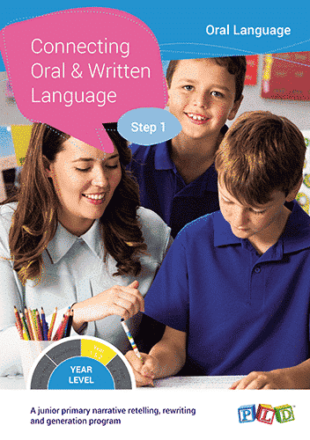
Instructional material outlining how to teach 6 to 8 year olds narrative oral retelling, rewriting and generation.
Although there are many types of genres, the most complex genre is narrative. The production of a narrative is more cognitively and linguistically demanding than participation in a conversation. Research repeatedly reports that narrative programs positively impact overall reading comprehension and written expression ability. Hence once skills are developed in this area, there is a flow on effect to all other forms of comprehension and written work. Within Connecting Oral and Written Language – Step 1 the initial oral stage is incredibly important. From a Speech Pathology perspective, oral expression ability is the precursor to written expression ability. Too often students are required to generate narratives before solid foundation skills are established. Remember students need to be provided with multiple opportunities to analyse and orally retell familiar narratives. In this way, they are rehearsing and practicing their oral language skills and simultaneously developing a solid understanding of narrative structure. Remember do not underestimate the value of the initial oral stages of narrative skills development. This program, designed by Speech Pathologists for 6 to 8 year olds features: Narrative tasks are presented in an order of ascending complexity (i.e. pre-narrative, oral narrative retells, written narrative retells and finally narrative generation). The manual outlines how to instruct 6 to 8 year old narrative ability and recommends over 45 suitable picture books. The classroom pack includes explicit narrative structure cards and display posters The programs within the range include: Early Years Programs: Picture Book Retelling – Step 1 Developing News Telling and Narrative Skills for 4 Year Olds Foundation Programs: Picture Book Retelling – Step 2 Developing News Telling and Narrative Skills for 5 Year Olds Year 1 & 2 Program: Connecting Oral and Written Language – Step 1 Year 3, 4, 5 & 6 Program Connecting Oral and Written Language – Step 2 This product is mentioned in the Year 1 & 2 Teaching Sequence Manual on page 20.
Generating Narratives – Set 1
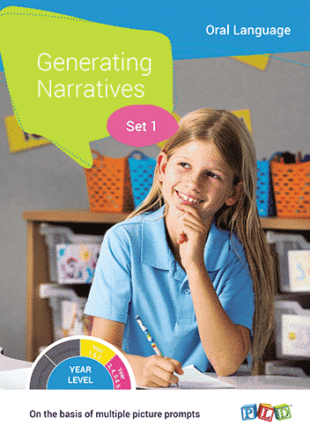
Building Verbal and Written Expression Through Picture Prompts
Generating Narratives: Set1 supports Year 1 to 6 students develop verbal and written storytelling skills. Using picture prompts, this resource breaks narratives into three key components: An introduction to set the scene. A complication or problem. Characters' thoughts and feelings. This program is ideal for building students' confidence in both oral and written expression, whilst fostering creativity and a deeper understanding of story structure. Program Includes: A4 book: Spiral-bound, full colour and no preparation required. 10 Storylines & Picture Cards: each with three accompanying A4 Picture Cards illustrating narrative structure (30 cards in total). Included story themes: Scarecrow Pet on the Loose Surprise Hatch Late for School Car Accident Flooded Town Escape Rabbit Campsite Danger Bolting Horse Baby Bird Falling Narrative Structure Cards: includes 10 x A4 coloured narrative structure poster cards for display. Implementation: Picture cards guide students through introductions, complications and emotions, providing repeated practise in generating ideas and composing stories. Other Programs within the Range: Generating Narratives – Set 2 Links to the Teaching Sequence Manuals: This product can be used to support the implementation of the Year 1 and 2 Teaching Sequence Manual on Page 27 This product can be used to support the implementation of the Year 3, 4, 5, and 6 Teaching Sequence Manual on Page 34
Speech Development Screen
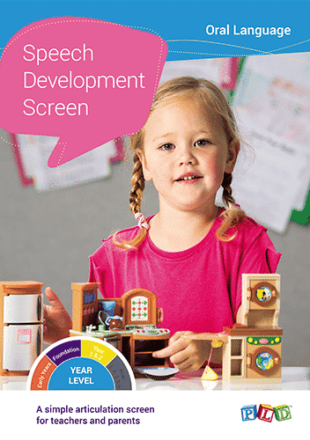
A simple articulation screen for teachers and parents.
Designed by Speech Pathologists for use in early childhood centres, schools and the home. The screen is quick and simple to administer. The screen identifies
Picture Book Retelling – Step 2
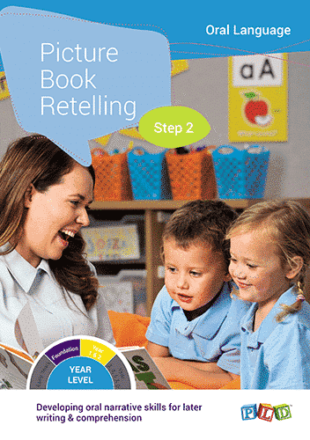
Developing oral narrative skills for later writing & comprehension.
Picture Book Retelling Step 2, is a teaching resource that attempts to break down early picture book retelling skills into simple sequential steps for teachers and parents to follow with their students and children. The program trains parents and teachers to identify where 4 and seven year old students need to develop and strengthen their oral language skills and presents specific techniques and supports to do so. Ideal for Foundation, Year 1 and Year 2 students, Picture Book Retelling – Step 2 provides: Assessment and monitoring procedures. Planning and programming supports. Visual Supports. Includes colour storytelling cards which assist early retelling efforts. Retell summaries for over 40 exciting and engaging picture books such as ‘Possum Magic’ By Mem Fox, ‘The Very Hungry Caterpillar’ By Eric Carle, ‘A sausage went for a walk’ By Elisha Marjid and many more! Techniques and strategies are outlined when a child provides poor retell of a story. Techniques and strategies to develop and accelerate language skills. Guidelines for structuring whole class, small group and individual activities. Comprehension questions. Retelling evaluation screen. Parent information sheets. A structured program designed by speech pathologists for teacher and parents. Storytelling can be a challenge for 4-7 year old students and teachers, however, practice is the key and the more students are exposed to the language associated with telling news or stories the more their expressive language will improve. This product is mentioned in the Foundation Teaching Sequence Manual on page 13. The programs within the range include: Early Years Programs: Picture Book Retelling – Step 1 Developing News Telling and Narrative Skills for 4 Year Olds Foundation Programs: Picture Book Retelling – Step 2 Developing News Telling and Narrative Skills for 5 Year Olds Year 1 & 2 Program: Connecting Oral and Written Language – Step 1 Year 3, 4, 5 & 6 Program Connecting Oral and Written Language – Step 2
Integrated SSP Kit for Year 1

Integrated SSP Kit for Year 2

Please note: The components in the Integrated SSP Kit cannot be separated. It is available for sale as one integrated kit only. It is a single-classroom kit and is not designed for sharing across classrooms. PLD’s Integrated SSP Kit for Year 2 streamlines the teaching experience within the framework of PLD’s Structured Synthetic Phonics […]
Please note: The components in the Integrated SSP Kit cannot be separated. It is available for sale as one integrated kit only. It is
Comprehension Questions for 3 to 9 Year Olds – Full Set (Variable Subscription)

This is a PLD Whole School Licence resource.
By purchasing this licence, this program will be accessible as a digital flipbook that will be stored in your secure account on the PLD website. The program will be accessible as a digital flipbook that teachers can access on any device for as long as the licence is active. A School Licence is valid for 12 months from the date of purchase and can be shared with all staff employed at the school.
We highly recommend that either the Principal, Deputy Principal or a member of the admin team purchase the School Licence in order to manage the account and its users. For more information, visit our Whole School Licence FAQ.
This is a PLD School Licence resource. By purchasing this licence, this program will be accessible as a digital flipbook that will be stored in
Integrated SSP Support Kit

Available for PRE-ORDER with delivery for the 2026 school year. The SSP Support Kit delivers Tier 3 instruction across three levels of targeted support. An individually administered program, delivered at least three times per week for approximately 20 minutes (extendable to 30-45 mins as required) A classroom component, enabling students receiving individualised support to remain […]
Available for PRE-ORDER with delivery for the 2026 school year. The SSP Support Kit delivers Tier 3 instruction across three levels of targeted support. An



